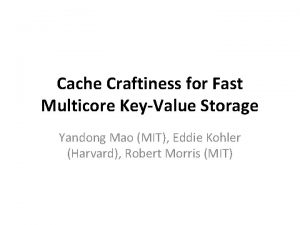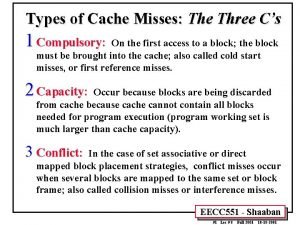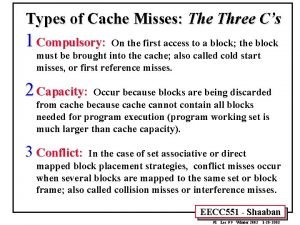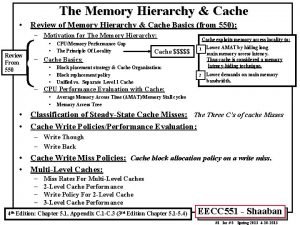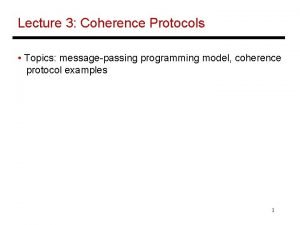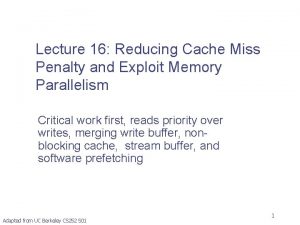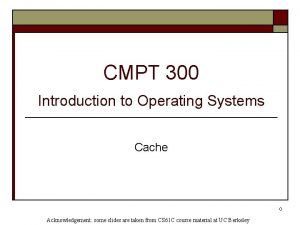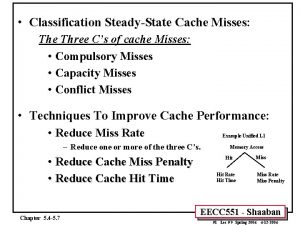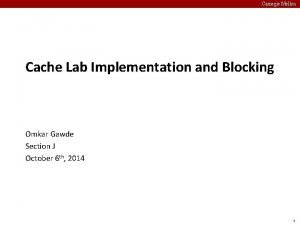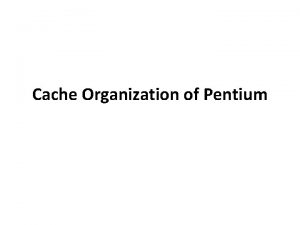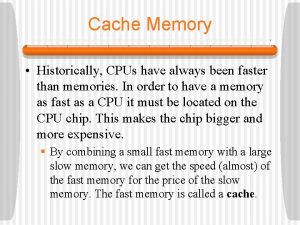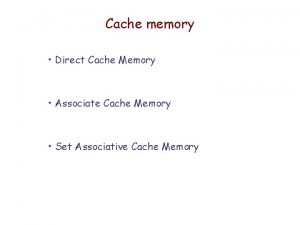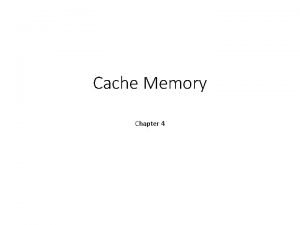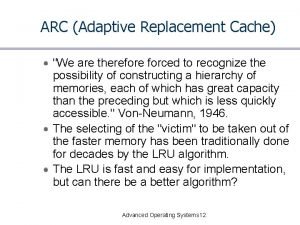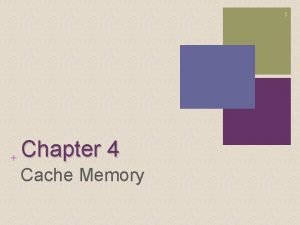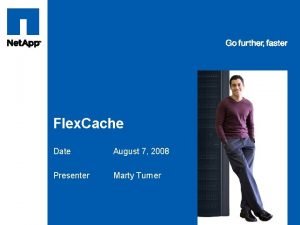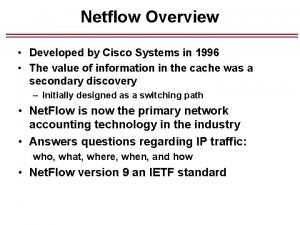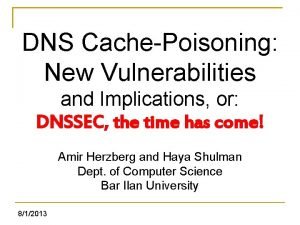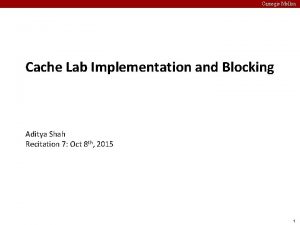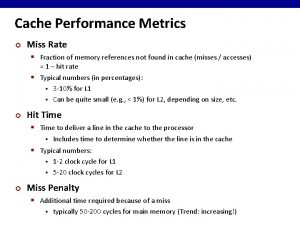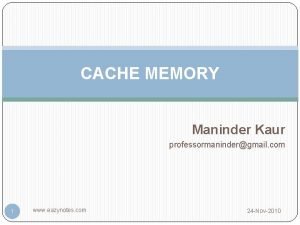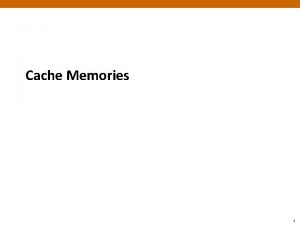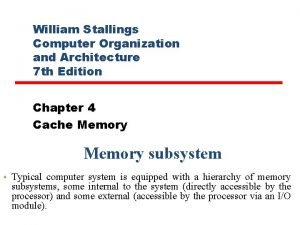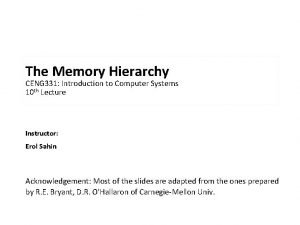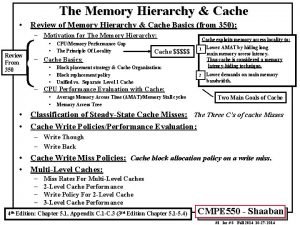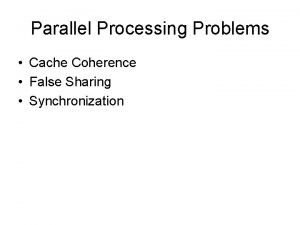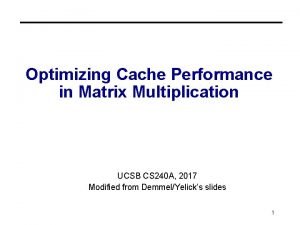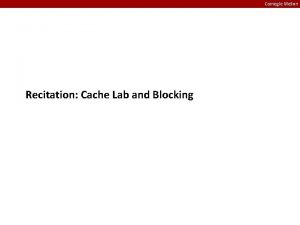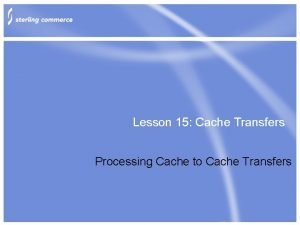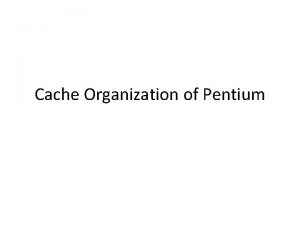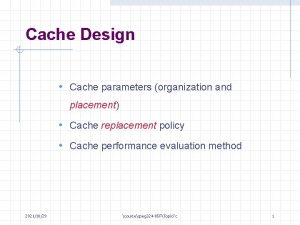Make Plone Fast Use Cache Fu to Make


























































































- Slides: 90

Make Plone Fast! Use Cache. Fu to Make Your Site Fly Geoff Davis geoff@geoffdavis. net Plone Symposium, 2006

Overview Big Picture ● – – How does Cache. Fu work? ● – – ● The Problem: Plone is slow The Solution: Cache. Fu Key concepts Gory details Squid

How fast is your site? ● Simplest measurement: Apache benchmark (ab) – – – ● comes with Apache 2. 0 distribution simulates lots of users hitting a single page sequentially and / or simultaneously measures pages served / second Limitations of ab – doesn't load associated images, CSS, JS ● – ● JS and CSS matter a lot! ~50% of your bandwidth doesn't know about browser caching, etc Better benchmarks feasible with Selenium? ?

How fast is Plone out of the box? ● ● ab = Apache benchmark – part of the Apache 2. 0 distribution ab -n 50 http: //localhost: 8080/myplonesite/ – – 50 requests for front page Key number to look for is “Requests per second: ” (average; median is better)

Using ab ● Tips: – Make sure you add the trailing “/” to the URL – Be sure your site has “warmed up” before running ● Lots of one-time startup expenses – – ● – ZODB needs to load objects into memory pages templates need to be parsed, etc Run twice and look only at second result Make sure Zope is not in debug mode

Results ● ~3. 5 requests/sec on my laptop – ● Front page is only part of the problem: – ● SLOW! also have ~200 K of CSS / JS / images! Quick tip: If you have an English-only site, delete Placeless. Translation. Service – Boosts speed to 4 req/sec (~15%)

Cache. Fu ● Download Cache. Fu – Not quite released yet – hopefully this week ● – Copy 4 packages to my Products directory: ● ● – svn co https: //svn. plone. org/svn/collective/Cache. Fu/branches/geoff d-cachefuageddon/ Cache. Setup Page. Cache. Manager Policy. HTTPCache. Manager CMFSquid. Tool Install Cache. Setup with Quick. Installer

Cache. Fu Simple Benchmark ● Repeat the ab test: – – Get ~35 req/second ~10 x faster; also improves JS, CSS, and images

Cache. Fu + squid ● Set up squid – – – ● Install squid Set up the squid. conf that ships with Cache. Fu Adjust squid settings in the cache settings portlet Run ab again – – Get 150 req/sec – 300 req/sec ~40 x-80 x faster

Transparency ● Cache. Fu is almost completely transparent – – – ● Cache. Fu caches content views (not everything) Big problem: cache needs to be purged when content changes Cache. Fu takes care of this for you When you update your content, changes will appear on your site immediately! – – – A few exceptions; we will discuss these Need to understand how things work to make this work for you Very straightforward in most cases

How does Cache. Fu work? ● Cache. Fu is pretty complicated – – ● ● Ideas are straightforward Infrastructure in Zope for implementing them is not Lots of partial solutions that step on each other Biggest value-add: (relatively) seamless integration Not a perfect solution Hopefully will provide a better way to think about the problem in Zope 3

Why is Plone slow? ● Multiple reasons ● In order of decreasing importance: – – ● Page rendering ZServer Network latency Connection setup times We will attack each problem separately – Multiple approaches to some problems

Speeding things up ● Page Rendering – – ● Lots of benchmarking Biggest time sink is TAL rendering Not much we can do about it EXCEPT not render Cache pages to reduce rendering time – Several different ways

Speeding things up ● ZServer sluggishness – ● ZServer is smart – ● Don't use ZServer when we don't have to Don't need brains to serve up static content Set up fast proxy cache (squid) – – Proxy cache handles static stuff ZServer handles things that require some smarts

Speeding things up ● Network latency – Tell browsers not to ask for things they don't need ● – Don't re-send pages when you don't have to ● – Caching! More caching! Compress content ● ● gzip HTML pages JS / CSS whitespace removal related tricks

Speeding things up ● Connection setup times – – – Combine multiple CSS files into one Combine multiple JS files into one Prevent unnecessary requests ● Cache as much as possible (but no more) in the client

Caching, and more Caching ● Common theme in all approaches: Cache! ● Several different types of caching – – – Cache in server memory Cache in proxy cache Cache in client's browser ● “Unconditional” client-side caching – ● Browser always uses local file “Conditional” client-side caching (NEW!) – Browser checks with server before using local file

More techniques Will touch on a few more approaches, but not in depth ● Tune the ZODB/ZEO object caches – speeds up Zserver ● Load balancing – reduces page rendering times under load ● Optimize your code – reduces page rendering time ● Cache intermediate code results – reduces page rendering time

Strategy 1: Cache static content in browser ● When user visits site, content stored in their browser's cache – ● ● HTTP headers tell how long to cache Subsequent requests pulled from local cache rather than server Most useful for static content that is viewed frequently – Images, CSS, JS

HTTP headers ● ● Understand HTTP headers to do caching right Good tutorial at http: //www. web-caching. com/mnot_tutorial/

HTTP header basics ● ● Will use both HTTP 1. 0 and 1. 1 headers in case ancient clients visit HTTP 1. 0 headers – Expires: [date and time] ● – Last-Modified: [date and time] ● ● – Browser will cache if date is in the future Complicated heuristics for image caching based on Last. Modified header absent more explicit info The longer your image has been unchanged, the longer the browser will cache it Headache: both require correct client clock

HTTP header basics ● HTTP 1. 1: much more fine-grained control – Cache-Control: [lots of options] ● Most important for our purposes: – – ● max-age=N ● browser will cache your content for N seconds ● preferable to Expires because makes no assumptions about client clock public ● tells browser OK to cache even when it might not otherwise Cache-Control options not to include (for now): – no-cache, no-store, must-revalidate, private

Setting HTTP headers ● Accelerated. HTTPCache. Manager – – – ● Part of CMF - sets cache headers for skin elements Used by Plone OOTB to set headers for static stuff HTTPCache Associate template / image / file with HTTPCache using metadata cache=HTTPCache One of the 10 places that headers get tweaked

Cache. Fu and headers ● Cache. Fu consolidates header-setting – – Most headers set in Caching. Policy. Manager Allows for much finer-grained control ● ● Cache. Fu replaces HTTPCache with a Policy. HTTPCache. Manager – ● We will need it! Farms HTTPCache's old job out to Caching. Policy. Manager Sets better default cache timeout – 24 hours instead of 1 hour

Caching. Policy. Manager ● Take a look in ZMI: caching_policy_manager – – ● Container full of header setting policies – – ● Details: Definitive Guide to Plone, Chapter 14 http: //docs. neuroinf. de/Plone. Book/ch 14. rst Each policy has a predicate Pages to be rendered walk through policies until they hit a true predicate, then headers are set You will not need to look in here much – Most of policy-choosing logic is elsewhere

Caching Policy ● ● Cache. Fu assigns the cache_in_browser policy to items associated with HTTPCache cache_in_browser policy: – key items: ● ● last-modified = python: object. modified() max-age = 86400 – ● s-max-age = 86400 – ● 86400 secs = 24 hours instructions to squid public – Use cached items even in situations when maybe not OK (e. g. when authorized, possibly with https connections, etc)

Caching in Browser ● cache_in_browser policy gives us the least control – – ● Once something is in the browser, it is stuck there Browser won't check for anything newer for 24 hours Takes a big load off server, though – – Safe to use this policy for things that rarely change If you plan to change stuff, consider: ● ● lower max-age time limit the day before increase again when you are done

Testing the headers ● Live. HTTPHeaders plug-in for Fire. Fox / Mozilla – – Your new best friend http: //livehttpheaders. mozdev. org ● Invaluable for testing caching Shows all request and response headers ● Let's take a look ●

Live. HTTPHeaders ● Tips: – – Clear your browser cache manually before starting a session Add a favicon. ico file to the Zope root to avoid 404 s

Resource. Registries ● Most of the content associated with HTTPCache is images JS and CSS used to be, but no more ● Resource. Registries are the new way to go ● – In the ZMI: ● ● – portal_css portal_javascripts Let's take a look

Resource. Registries ● ● Look at portal_css Lots of CSS files registered Line in main_template pulls in all registered CSS in the page <head> section Options: – – Enabled: lets you turn on/off file inclusion TAL condition: lets you conditionally include Merging allowed: can file be merged? Caching allowed: used for RR's internal caching (which we bypass)

Resource. Registries ● RR serves up a set of merged CSS files with URLs like this: – – portal_css/Default%20 Skin/plone. Styles 1234. css Skin name is in the URL so that different skins have distinct URLS ● – Avoids user retrieving cached css file for one skin when viewing a different skin Number in filename is version number ● every time you hit Save button, version number changes

Resource. Registries ● Version number is VERY IMPORTANT – – Means you can cache stuff forever in browser When you change your CSS, hit Save ● ● ● Merged filename changes Pages now point to new CSS file; user won't see the old one CSS and JS are ~1/2 of bandwidth on a typical site – If you have repeat visitors, long-time caching is great

Resource. Registries ● Added bonus: – – ● RR 1. 3 does safe CSS and JS compression (Plone 2. 1. 2 ships with RR 1. 2) Ideal solution: serve gzipped CSS / JS – – Buggy in many browsers, unfortunately RR instead strips whitespace, other tricks ● ● – “Safe” compression cuts CSS and JS by about 25% each More aggressive compression cuts JS by ~50% RR does this on the fly each request ● Cache. Fu caches the results so RR only compresses once

Resource. Registries ● Cache. Fu bypasses RR's caching machinery – ● Routes JS and CSS through caching_policy_manager Policy used is cache_file_forever – – CSS and JS can live on the browser for a year Really important to remember to Save!

Resource. Registries ● Tips: – – Files have to be mergeable for renaming to work Use debug mode for development and debugging ● – Files don't get merged or cached Pages cached in squid may refer to the old CSS / JS files ● ● If you make big CSS/JS changes and want them to appear immediately, you will also have to purge squid purging script (purgesquid) is supplied

Quick Recap ● Step 1: Cache your static content in the browser – Associate files and images in your skins with HTTPCache ● ● – Use cache=HTTPCache in the. metadata file Cache. Fu will do the rest Register your CSS and JS with portal_css/portal_js ● ● ● Make them mergeable Save when css/js change Cache. Fu will take care of caching

Quick Recap ● Keep limitations in mind – Only helps if people load the URL more than once! ● – Great for CSS / JS / images that appear on all pages Once it's on the browser, can't change until it expires ● Unless you are using something cool like RR

Proxy cache ● Benefit of browser cache: – ● Drawback of browser cache: – ● Every request served by cache is one less request served by ZServer Can't invalidate stale content Alternative for content that changes more frequently: use a proxy cache

Strategy 2: Proxy Caching ● ● ● Idea: put a fast but dumb proxy cache in front of Zope Proxy cache serves up (static) content, keeps load off Zope can tell proxy cache when content expires so you don't serve up stale content

Proxy cache ● Because it is server side, cached content is shared – – – Browser cache only helps if 1 client requests same resource twice Proxy cache helps if 2 (anonymous) people request same thing even if they are different people Much less help when content is personalized, though ● Our strategy: cache anonymous content ● Possible to expand if content is personalized based on, say, roles instead of username ● Will talk more about personalized content later

Plone and content caching ● ● By default, Plone sends no Cache-Control header, which means that pages won't be cached in general Anything using main_template has headers set in global_cache_headers. pt – In CMFPlone/skins/plone_templates ● – contains Cache-Control: no-cache Cache. Fu overrides, uses caching_policy_manager instead

Plone and content caching ● Want to override default headers for a single page? – Simplest way: call request. RESPONSE. set. Header in body of template. ● ● – ● Overrides previous header, affects only template in question. May get stomped by caching_policy_manager Harder way: create a caching_policy_manager policy (You won't need to do this in general)

Content cache headers ● ● Goal is to cache anonymous content views Not much point caching personalized views – – ● Not enough hits per cached page to justify Fills up the cache How do we control content cache headers? – – With a caching policy, of course Content views will use 2 different policies ● ● cache_in_squid if you are anonymous cache_in_memory if you are authenticated

Content cache policies ● ● Leave content in squid; purge as needed cache_in_squid – max-age = 0 ● – s-max-age = 86400 ● ● ● Don't cache in the browser! Cache in squid for up to 24 hours Keep out of squid cache_in_memory – – Don't cache in browser or squid max-age = 0, s-max-age = 0

How policies are assigned ● How does Zope know what caching policies to apply? – Cache setup tool controls everything: The One Ring ● – Nice portlet – let's look ● – Site setup -> Cache Configuration Tool Main tab controls relationship with squid ● – Integrates the 7 different products Talk about that later Next tabs control policy assignments

Cache configuration tool ● ● ● When an object looks for headers, it gets sent to Cache. Setup walks through assignment policies to figure out what the appropriate caching policy is HTTPCache content – – – Assigns all content associated with HTTPCache Both anonymous and authenticated users get “Cache in browser” policy Hopefully reasonably self-explanatory

Cache configuration tool ● ● Next tab: Plone content types Have an object + template in hand. Does the policy apply? – – Look at content type – is it in the list? Look at template ● ● – Is it a default view for the object? Is it on the list of templates? Look at request – is there anything that should stop caching?

Cache configuration tool ● ● ● Ok, so the configuration policy applies, now what? Need to figure out a caching policy 2 methods: – – ● Use policy specified for anonymous or authenticated users Get the policy ID from an external script For default views of main Plone content objects: – – cache in squid for anonymous users cache in memory for authenticated users

Cache configuration tool ● For default views of main Plone container objects: – ● cache in memory for anonymous and authenticated users Reason: – – Can purge content objects when they change, BUT Container views change when any of their contents change ● ● So either all content has to purge parent OR Just cache in RAM and work out purging another way (will discuss later)

Caching Your Views ● Recommended method: – ● Add a new assignment policy In portal_cache_settings, add a new content policy – – Select your content types Indicate that default views should be cached Choose type of caching policy for anonymous and authenticated Configure ETags (will discuss later – default Plone Etags are good starting point)

Purging ● What happens when content changes? – CMFSquid. Tool purges the object ● – – ● Cache. Setup configures squidtool so you don't have to Monkey patches index, unindex, reindex, etc When an object is created / modified / deleted, cache is purged Cache configuration tool figures out the right pages to purge – – Typically just the views and templates specified If you want extras, you can add a script

Purging ● Plone content types – ● uses script to purge extra pages Why? – If you modify the file “myfile”, need to purge: ● ● – If you modify the image “myimg”, need to purge ● ● ● default views: myfile, myfile/view also myfile/download default views: myimg, myimg/view also myimg/image_thumbnail, etc Script supplies the extra /download, image_thumbnail, etc

Proxy Caches ● Squid – – – ● free, open source; runs on Linux, Windows, OSX http: //www. squid-cache. org Super fast (~400 requests/second on mid-range box) Some (but probably not all) of Cache. Fu strategy should work with IIS + Enfold Enterprise Proxy – http: //www. enfoldsystems. com/Products/EEP

Why not Apache? ● ● ● Apache + mod_cache – Lots of documentation about using Apache for caching Problem: mod_cache doesn’t support purging – No easy way to delete stale pages from cache Should be possible to modify Cache. Fu to get some (but not full) benefit from Apache – 1 -2 days work – Sponsorship welcome!

Using Squid ● ● Excellent documentation available (Only need to read a few chapters, not whole book)

Using Squid ● Squid has a reputation of being complex ● Problem is that default squid. conf is 3500 lines – – ● 99% documentation most options don't apply Cache. Fu contains sample squid. conf – – 137 lines (including comments) straightforward to configure

Squid configuration ● Cache. Fu has sample configurations for – – squid by itself squid behind Apache ● – ● useful if you need to wire together different web apps and want to use mod_rewrite, etc setup is similar Pick the appropriate setup

Configuring squid ● Go to the directory for the configuration you have chosen – ● Edit squid. conf and follow the instructions – ● squid_direct or squid_behind_apache Walkthrough Edit redirector_class. py and set up the redirection rules – – Syntax is like mod_rewrite for Apache Walkthrough

Setting up squid ● ● Copy everything (squid. conf, all. py files) to /etc/squid Fire up squid!

Setting up squid ● Tips: – Check file permissions ● ● – squid must have read access to squid. conf, i. Redirector. py, squid. Acl. py, and redirector_class. py squid must have execute access to i. Redirector. py and squid. Acl. py and i. Redirectory. py get called directly ● ● ● First line is #!/usr/bin/python -Ou If your python is not at /usr/bin/python, change the path to python in the first lines of these files Make sure you can run both of these from the command line without getting an exception

Setting up squid ● More tips: – While debugging your squid configuration, run squid from the command line and echo errors to the console: ● – To stop squid from the command line, use ● – /usr/sbin/squid -k kill To reconfigure squid after modifying squid. conf, use: ● – /usr/sbin/squid -d 1 /usr/sbin/squid -k reconfigure Use the Cache. Fu purgesquid script to purge the cache

Setting up squid ● More tips: – Look at squid's logs if you have problems ● /var/log/squid/cache. log – squid messages about its internal state – – ● If you notice all squid's external processes are dying, it probably means that you have a problem with your python path in i. Redirector. py or squid. Acl. py Try running these python files from the command line to see what's going on. Use “. /i. Redirector. py”, NOT “python i. Redirector. py” /var/log/squid/access. log – squid messages about cache hits and misses

Setting up squid ● Tips: – – i. Redirector. py does URL rewriting Uses redirector_class. py as a helper ● ● Both i. Redirector. py and redirector. py do debug logging Edit them and replace “debug = 0” with “debug = 1” if you have problems

Setting up squid ● ● Once you have squid working, It Just Works Setup can be a headache the first time – Tips should help a lot

Configuring Cache. Fu for Squid ● ● Once squid runs, tell Zope about it Go to first pane of Cache configuration tool – Indicate URLs of your site ● – include all URLs, e. g. http: //www. mysite. com, https: //www. mysite. com, http: //mysite. com, etc If squid behind apache, URL of squid (typically http: //localhost: 3128)

Vary header and gzipping ● Set the Vary header (default should be OK) – – Vary header tells squid to store different versions of content depending on the values of the headers specified Vary: Accept-Encoding for gzip ● ● ● One version for browsers that accept gzipped content One version for those that don't Select gzipping method (default is recommended) – – Gzipping cuts down network latency Content cached in gzipped form so only gzip once

Demo ● Let's try it out! ● Tips: – – Use Live. HTTPHeaders to see if getting cache hits Look at headers: ● – – X-Cache: HIT or X-Cache: MISS If you don't see any HITs, clear your browser cache manually and try again If that fails, something may be wrong

Strategy 3: Load Balancing ● Zope Enterprise Objects let you do load balancing – – – ● ZEO server = essentially an object database ZEO client executes your python scripts, serves up your content, etc ZEO comes with Zope Set up multiple ZEO clients on multiple machines or multiple processors (single instance of Zope won't take much advantage of multiple processors)

Setting up ZEO ● ● ● You can transform a Zope site into a ZEO site using the mkzeoinstance. py script in ~Zope/bin Change a few lines in ~instance/etc/zope. conf and ~instance/etc/zeo. conf and you are good to go See Definitive Guide to Plone, Chapter 14 – http: //docs. neuroinf. de/Plone. Book/ch 14. rst

Squid + ZEO ● ● ● Main idea: give your proxy cache lots of places from which to get content it can't serve Squid can in theory take care of load balancing I would use pound instead – – pound = load-balancing proxy designed for Zope http: //www. apsis. ch/pound/ Put pound between squid and ZEO clients Big advantage if you use sessions – pound keeps client talking to same back-end server

Resource requirements ● My site: 20 K page views/day – – ● plone. org: – – ● ● 1 squid instance, 1 ZEO client 2. 4 GHz P 4 + 1 G RAM 1 squid instance + 2 ZEO clients 2 x 3 GHz Xeon box with 2 GB of RAM Bulk of load is from authenticated clients Don't need that much power, especially if most clients are anonymous squid is very efficient Main requirement is lots of memory for Zope

Strategy 4: Use Entity Tags ● ● ETags let us do smart browser caching The idea: – ETag = arbitrary string, should have the property: ● – – If I have 2 files with same ETag, files should be the same Send an ETag to browser with a page Browser caches the page Before rendering from cache, browser sends ETag of cached page to server Server responds with Status 304 + no page (meaning cached stuff OK) or Status 200 + new page

ETags ● What are good ETags? – ● Depends on what we are serving up Example: Images – – – 2 images with same URL and same modification time are probably the same ETag for images, files can just be last modified time ETags not really useful for files and images, since we can do a conditional request based on modification time

ETags ● Example: document – ETag for document should include modification time ● – Should depend on authenticated member ● – That lets us distinguish different versions of the doc Since we have personalization in document view Should depend on state of the navtree, other portlets

Setting ETags ● ● Cache. Fu provides an easy way to generate ETags Go to policy for Plone content in Cache configuration portlet – – Look at ETag section Ingredients for building an Etag ● ● Use member ID (personalization) Time of last catalog modification (covers age of document + navtree state) REQUEST vars: month, year, orig_query (covers state of calendar portlet) Time out after 3600 secs

ETags ● ETags useful for 2 things – First, allows for smart conditional browser caching ● – If document changes or something in document's containing folder changes or calendar changes or logged in member changes, ETag will change Second, provides a useful cache key for a RAM cache

Page. Cache. Manager ● Page. Cache. Manager stores full pages + headers in a memory – – ● ● ● Uses ETags as cache key, so ETag is required ETags are set using Caching. Policy. Manager policy If template uses Cache configuration tool to generate an ETag and policy is not “Do not cache” Cache. Fu automatically associates templates that have ETags generated Content views automatically cached in memory

Page. Cache. Manager ● Try it out ● Look for X-Pagecache: HIT

Things you should know ● Some things to watch out for when digging deeper – If browser has a page in hand, will do a conditional GET ● ● ● – – GET /foo If-None-Match: ETAG-OF-PAGE-IN-HAND If-Modified-Since: LAST-MOD-OF-PAGE-IN-HAND Squid can handle If-Modified-Since but is too dumb to deal with If-None-Match Any requests with an If-None-Match bypass squid ● Code in squid. Acl. py is used to do this

More things you should know ● Squid is not typically very useful for caching content from authenticated users – ● squid. Acl. py causes squid to be bypassed if the user is authenticated Squid IS useful for caching images and files even if user is authenticated – Code in squid. conf that tells squid to always use the cache for files ending with. js, . css, . jpg, etc

More things you should know ● Images and Files get routed through Caching. Policy. Manager through a nasty method – – ● Monkey patch associates them with Default. Cache is an HTTPPolicy. Cache. Manager Existing caching policies assume that images and files may have security on them but are otherwise same for authenticated anonymous users – May be be possible to work around but will require some effort (weird use case)

Strategy 5: Optimize Your Code ● ● Don't guess about what to optimize – use a profiler Several available – Zope Profiler: ● – Call Profiler: ● – http: //zope. org/Members/richard/Call. Profiler Page Template Profiler: ● ● http: //www. dieter. handshake. de/pyprojects/zope/ http: //zope. org/Members/guido_w/PTProfiler Identify and focus on slowest macros / calls

Code Optimization: Example ● Suppose you find that a portlet is your bottleneck – ● ● How to fix? Idea: don't update calendar portlet every hit – – – ● Calendar portlet, for example, is pretty expensive Update, say, every hour Cache the result in memory Serve up the cached result Similar idea applies to other possible bottlenecks: – Cache the most expensive pieces of your pages

RAMCache. Manager ● ● ● RAMCache. Manager is a standard Zope product Caches results of associated templates / scripts in memory Caveats: – – ● Can't cache persistent objects Can't cache macros Calendar portlet is a macro – how can we cache it?

Trick: Caching Macro Output ● Idea: – – – create a template that renders the macro output of template is snippet of HTML, i. e. a string cache output of the template

Caching the Calendar ● Step 1: Create a template called cache_calendar. pt: <metal: macro use-macro=”here/portlet_calendar/macros/portlet” /> ● ● Step 2: In the ZMI, add a RAMCache. Manager to your site root Step 3: in the RAMCache. Manager, set the REQUEST variables to AUTHENTICATED_USER, leave the others as defaults (this caches one calendar per user)

Caching the Calendar ● ● Step 4: Associate cache_calendar. pt with your new RAMCache. Manager. Output of cache_calendar. pt will now be cached for 1 hour. Step 5: In your site's properties tab, replace here/portlet_calendar/macros/portlet with here/cache_calendar Voila! Use RAMCache. Manager to cache output of slow scripts, etc.

Future Directions ● Make Cache. Fu more Apache-friendly – ● General clean-up and polish – – ● Should be possible to make Cache. Fu work without squid (currently only provides limited benefits) Autogenerate squid config files More unit tests Minor refactoring for simplification Let Page. Cache. Manager use memcached Even bigger gains to be had. . .

Future directions ● Poor man's ESI – – ● ● ● Split out chunks of pages Cache them independently Insert SSI directives in their place Have Apache reassemble chunks Header, footer, portlets, personal bar, etc could all be cached and invalidated separately Cache. Fu speeds up views – this could speed up everything Sponsorship welcomed! geoff@geoffdavis. net
 Cache craftiness for fast multicore key-value storage
Cache craftiness for fast multicore key-value storage Plone vs drupal
Plone vs drupal Plone training
Plone training Plone vs drupal
Plone vs drupal Plone sso
Plone sso Example of acid-fast bacteria
Example of acid-fast bacteria Acid fast and non acid fast bacteria
Acid fast and non acid fast bacteria Common case fast
Common case fast Pentium 4 cache organization
Pentium 4 cache organization Types of cache misses
Types of cache misses Types of cache miss
Types of cache miss Cache tag size raid 0
Cache tag size raid 0 Cache tag size raid 0
Cache tag size raid 0 Cpu cache
Cpu cache Karakteristik memori
Karakteristik memori Karakteristik dari cache memory
Karakteristik dari cache memory Cache fusion
Cache fusion Set associative mapping in cache memory
Set associative mapping in cache memory Rom ram cache
Rom ram cache Ligne de contour
Ligne de contour Techniques for reducing cache misses
Techniques for reducing cache misses Cache coherence protocols
Cache coherence protocols Techniques for reducing cache misses
Techniques for reducing cache misses Write around cache
Write around cache Direct cache mapping
Direct cache mapping Direct-mapped cache
Direct-mapped cache Verilog
Verilog How to calculate cache miss rate
How to calculate cache miss rate Write around cache
Write around cache Arm cache organization
Arm cache organization Direct mapped cache
Direct mapped cache Set associative mapping in cache memory
Set associative mapping in cache memory Logical cache
Logical cache Cache
Cache Techniques for reducing cache misses
Techniques for reducing cache misses Cache vs memory
Cache vs memory Cachelab
Cachelab Cache replacement championship
Cache replacement championship The pentium has kb instruction and kb data cache.
The pentium has kb instruction and kb data cache. They've always been faster
They've always been faster Cache operation
Cache operation Cache memory design
Cache memory design Characteristics of cache
Characteristics of cache Cache memory adalah
Cache memory adalah Cache coherence for gpu architectures
Cache coherence for gpu architectures Cache attacks and countermeasures: the case of aes
Cache attacks and countermeasures: the case of aes Spack hpc
Spack hpc Azure labs for education
Azure labs for education Neminath hubballi
Neminath hubballi Adaptive replacement cache
Adaptive replacement cache Associative cache mapping
Associative cache mapping Cache 3 diploma
Cache 3 diploma Flex cache
Flex cache Capital of carnatic
Capital of carnatic Netflow overview
Netflow overview Mocha cache
Mocha cache Memory address in hexadecimal
Memory address in hexadecimal Momento cache
Momento cache Fugeal cache
Fugeal cache Cache
Cache Unity and coherence
Unity and coherence Cache coherence tutorial
Cache coherence tutorial Dns cache poisoning attack tutorial
Dns cache poisoning attack tutorial Mesi cache
Mesi cache Alteryx cache and run workflow
Alteryx cache and run workflow Set associative cache
Set associative cache Cache efficient matrix transpose
Cache efficient matrix transpose Cache performance metrics
Cache performance metrics Types of cache mapping
Types of cache mapping Page fault
Page fault Cache memory organization
Cache memory organization Chained cache coherence protocol
Chained cache coherence protocol Branchcache hosted cache server
Branchcache hosted cache server Arc: a self-tuning, low overhead replacement cache
Arc: a self-tuning, low overhead replacement cache Cache inclusive exclusive
Cache inclusive exclusive Writeback cache
Writeback cache Windows cache manager
Windows cache manager Direct mapping cache organization
Direct mapping cache organization Cache
Cache Three level cache organization
Three level cache organization Gsak alternative
Gsak alternative False sharing cache
False sharing cache Matrix multiplication cache optimization
Matrix multiplication cache optimization Openldap proxy cache
Openldap proxy cache Cache in a sentence
Cache in a sentence Makalah cache memory
Makalah cache memory 351 cache simulator
351 cache simulator Cache coherence example
Cache coherence example Cache do alok
Cache do alok Cache memory is invisible to the os.
Cache memory is invisible to the os. Cache lab cmu
Cache lab cmu
